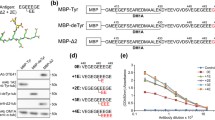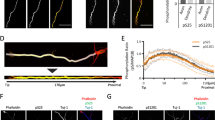Summary
Differential vulnerability of the major components of microtubules was examined in ischemic gerbil brains by a light microscopic, immunohisto-chemical method using monoclonal antibodies for microtubule-associated protein (MAP) 1A and MAP2, polyclonal antibody for MAP1 and 2 as well as monoclonal antibody for α-tubulin. Progressive cerebral ischemia during unilateral carotid occlusion for 5, 15 and 120 min and reperfusion for 3, 12 and 48 h following bilateral carotid occlusion for 10 min were studied. Ischemic lesions in the subiculum-CA1 region were visualized by all antibodies after ischemia for 5 min but the antibody for α-tubulin was less sensitive. The antibody for α-tubulin was also less sensitive than antibodies for MAPs for detection of early postischemic lesions. Differential sensitivity was also observed in the cerebral cortex and other brain regions. Microtubules in myelinated axons were more stable than those in dendrites. The observed loss of immunohistochemical reactivities for MAPs and α-tubulin may have been caused by activation of calcium-dependent proteolytic enzymes such as calpains. The discrepancy between MAPs and α-tubulin could be due to differences in affinities or topographic distributions of these proteins within microtubules.
Similar content being viewed by others
References
Amos LA (1977) Arrangement of high molecular weight associated proteins on purified mammalian brain microtubules. J Cell Biol 72:642–654
Baylay PM, Martin SR (1986) Inhibition of microtubule elongation by GDP. Biochem Biophys Res Commun 137:351–358
Bernhardt R, Matus A (1984) Light and electron microscopic studies of the distribution of microtubule-associated protein 2 in rat brain: a difference between the dendritic and axonal cytoskeletons. J Comp Neurol 226:203–221
Bershadsky AD, Gelfand VI (1981) ATP-dependent regulation of cytoplasmic microtubule disassembly. Proc Natl Acad Sci USA 78:3610–3613
Billger M, Wallin M, Karlsson J-O (1988) Proteolysis of tubulin and microtubule-associated proteins 1 and 2 by calpain I and II. Difference in sensitivity of assembled and disassembled microtubules. Cell Calcium 9:33–44
Bloom GS, Schoenfeld TA, Vallee RB (1984) Widespread distribution of the major polypeptide component of MAP1 (microtubule-associated protein 1) in the nervous system. J Cell Biol 98:320–330
Bloom GS, Luca FC, Vallee RB (1985) Microtubule-associated protein 1B: identification of a major component of the neuronal cytoskeleton. Proc Natl Acad Sci USA 82:5404–5408
Brengman JM, Morimoto K, Yanagihara T (1988) Purine nucleotides and phosphocreatine in postischemic gergil brain. Trans Am Soc Neurochem 19:147
Davies KJA (1987) Protein damage and degradation by oxygen radicals. 1. General aspects. J Biol Chem 262:9895–9901
Hamel E, Batra JK, Huang AB, Lin CM (1986) Effects of pH on tubulin-nucleotide interactions. Arch Biochem Biophys 245:316–320
Harris RJ, Symon L, Branston NM, Bayhan M (1981) Changes in extracellular calcium activity in cerebral ischemia. J Cereb Blood Flow Metab 1:203–209
Hatakeyama T, Matsumoto M, Brengman JM, Yanagihara T (1988) Immunohistochemical investigation of ischemic and postischemic damage after bilateral carotid occlusion in gerbils. Stroke 19:1526–1534
Hsu S-M, Raine L, Fanger H (1981) The use of antiavidin antibody and avidin-biotin-peroxidase complex in immuno-peroxidase technics. Am J Clin Pathol 57:816–821
Huber G, Matus A (1984) Immunocytochemical localization of microtubule-associated protein 1 in rat cerebellum using monoclonal antibodies. J Cell Biol 98:777–781
Jameson L, Caplow M (1981) Modification of microtubule steady-state dynamics by phosphorylation of the microtubule-associated proteins. Proc Natl Acad Sci USA 78:3413–3417
Job D, Fischer EH, Margolis RL (1981) Rapid disassembly of cold stable microtubules by calmodulin. Proc Natl Acad Sci USA 78:4679–4682
Johnson GVW, Jope RS, Binder LI (1989) Proteolysis of tau by calpain. Biochem Biophys Res Commun 163:1505–1511
Letterier JF, Liem R, Shelanski M (1982) Interactions between neurofilaments and microtubule-associated proteins: a possible mechanism for intra-organellar bridging. J Cell Biol 95:982–986
Lindenbaum MH, Carbonetto S, Mushynski WE (1987) Nerve growth factor enhances the synthesis, phosphorylation, and metabolic stability of neurofilament proteins in PC12 cells. J Biol Chem 262:605–610
Lowry OH, Passonneau JV, Hasselberger FX, Schultz DW (1964) Effect of ischemia on known substrates and cofactors of the glycolytic pathway in brain. J Biol Chem 239:18–30
Malik MN, Fenko MD, Iqbal K, Wisniewski HM (1983) Purification and characterization of two forms of Ca2+-activated neutral protease from calf brain. J Biol Chem 258:8955–8962
Martins E, Inamura K, Themner K, Malmqvist KG, Siesjö BK (1988) Accumulation of calcium and loss of potassium in the hippocampus following transient cerebral ischemia: a proton microprobe study. J Cereb Blood Flow Metab 8:531–538
Matsumoto M, Yamamoto K, Homburger HA, Yanagihara T (1987) Early detection of cerebral ischemic damage and repair process in the gerbil by use of an immunohistochemical technique. Mayo Clin Proc 62:460–472
Matus AI, Walters BB, Mughal S (1975) Immunohistochemical demonstration of tubulin associated with microtubules and synaptic junctions in mammalian brain. J Neurocytol 4:733–744
Matus A, Bernhardt R, Bodmer R, Alaimo S (1986) Microtubule-associated protein 2 and tubulin are differently distributed in the dendrites of developing neurons. Neuroscience 17:371–389
McCord JM (1985) Oxygen-derived free radicals in postischemic tissue injury. N Engl J Med 312:159–163
Meyer FB, Anderson RE, Sundt TM Jr, Yaksh TL (1986) Intracellular brain pH, indicator tissue perfusion, electroencephalography and histology in severe and moderate focal cortical ischemia in the rabbit. J Cereb Blood Flow Metab 6:71–78
Nihida E, Kuwaki T, Sakai H (1981) Phosphorylation of microtubule-associated proteins (MAPs) and pH of the medium control interaction between MAPs and actin filaments. J Biochem (Tokyo) 90:575–578
Okabe E, Odajima C, Taga R, Kukreja RC, Hess ML, Ito H (1988) The effect of oxygen free radials on calcium permeability and calcium loading at steady state in cardiac sarcoplasmic reticulum. Mol Pharmacol 34:388–394
Sandoval IV, Weber K (1978) Calcium-induced inactivation of microtubule formation in brain extracts. Presence of a calcium-dependent protease acting on polymerization stimulating microtubule-associated proteins. Eur J Biochem 92:463–470
Schubert P, Kreutzberg GW, Lux HD (1972) Neuroplasmic transport in dendrites; effect of colchicine on morphology and physiology of motoneurones in the cat. Brain Res 47:331–343
Schulman H (1984) Differential phosphorylation of MAP-2 stimulated by calcium-calmodulin and cyclic AMP. Mol Cell Biol 4:1175–1178
Seubert P, Lee K, Lynch G (1989) Ischemia triggers NMDA receptor-linked cytoskeletal proteolysis in hippocampus. Brain Res 492:366–370
Shelanski ML, Gaskin F, Cantor CR (1973) Microtubule assembly in the absence of added nucleotide. Proc Natl Acad Sci USA 70:765–768
Siman R, Noszek JC, Kegerise C (1989) Calpain I activation is specifically related to excitatory amino acid induction of hippocampal damage. J Neurosci 9:1579–1590
Terasaki M, Chen LB, Fujiwara K (1986) Microtubules and the endoplasmic reticulum are highly interdependent structures. J Cell Biol 103:1557–1568
Towbin H, Staehelin T, Gordon J (1979) Electrophoretic transfer of proteins from polyacrylamide gels to nitrocellulose sheets: Procedure and some applications. Proc Natl Acad Sci USA 76:4350–4354
Walker PR, Whitfield JF (1985) Cytoplasmic microtubules are essential for the formation of membrane-bound polyribosomes. J Biol Chem 260:765–770
Weisenberg RC, Deery WJ (1981) The mechanism of calcium-induced microtubule disassembly. Biochem Biophys Res Commun 102:924–931
Yamamoto H, Fukunaga K, Goto S, Tanaka E, Miyamoto E (1985) Ca2+, calmodulin-dependent regulation of microtubule formation via phosphorylation of microtubule-associated protein 2, τ factor, and tubulin, and comparison with the cyclic AMP-dependent phosphorylation. J Neurochem 44:759–768
Yamamoto H, Saitoh Y, Fukunaga K, Nishimura H, Miyamoto E (1988) Dephosphorylation of microtubule proteins by brain protein phosphatases 1 and 2A and its effect on microtubule assembly. J Neurochem 50:1614–1623
Yamamoto K, Morimoto K and Yanagihara T (1986) Cerebral ischemia in the gerbil: transmission electron microscopic and immunoelectron microscopic investigation. Brain Res 384:1–10
Yanagihara T, McCall JT (1982) Ionic shift in cerebral ischemia. Life Sci 30:1921–1925
Yanagihara T, Yoshimine T, Morimoto K, Yamamoto K, Homburger HA (1985) Immunohistochemical investigation of cerebral ischemia in gerbils. J Neuropathol Exp Neurol 44:204–215
Yoshimine T, Morimoto K, Homburger HA, Yanagihara T (1984) Immunohistochemical localization of creatine kinase BB-isoenzyme and tubulin in gerbil brains. Neuroscience 12:959–969
Yoshimine T, Morimoto K, Brengman JM, Homburger HA, Mogami H, Yanagihara T (1985) Immunohistochemical investigation of cerebral ischemia during recirculation. J Neurosurg 63:922–928
Zingheim HP, Herzog W, Weber K (1979) Differences in surface morphology of microtubules reconstituted from pure brain tubulin using two different microtubule-associated proteins: the high molecular weight MAP2 protein and tau proteins. Eur J Cell Biol 19:175–183
Author information
Authors and Affiliations
Additional information
Supported by the grant NS-06663 from the National Institutes of Health, U.S. Public Health Service
Rights and permissions
About this article
Cite this article
Yanagihara, T., Brengman, J.M. & Mushynski, W.E. Differential vulnerability of microtubule components in cerebral ischemia. Acta Neuropathol 80, 499–505 (1990). https://doi.org/10.1007/BF00294610
Received:
Accepted:
Issue Date:
DOI: https://doi.org/10.1007/BF00294610




